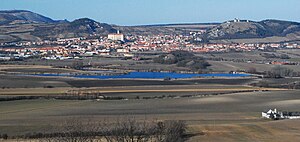Šibeník (Mikulov)
| Šibeník | ||
|---|---|---|

|
||
| View from the Schweinbarther mountain to the Šibeník and Mikulov | ||
| Geographical location | Czech Republic | |
| Tributaries | Mikulovský potok, Mikulovský odpad | |
| Drain | Mikulovský potok → Niklasgraben | |
| Location close to the shore | Mikulov | |
| Data | ||
| Coordinates | 48 ° 47 '7 " N , 16 ° 37' 36" E | |
|
|
||
| Altitude above sea level | 195 m nm | |
| surface | 23.12 ha | |
| volume | 347,000 m³ | |
| Maximum depth | 4.5 m | |
| Middle deep | 1.54 m | |
| Catchment area | 18.9 km² | |
The Šibeník (German gallows pond ) is a fish pond in the district of Mikulov ( Nikolsburg ) in the Czech Republic . It lies close to the Austrian border and belongs to the Pálava Protected Landscape Area .
geography
The Šibeník is located two and a half kilometers southwest of the center of Mikulov in the Wash Mountain Zone . To the south lies Drasenhofen , southwest of Kleinschweinbarth and Ottenthal . To the northeast rises the Šibeniční vrch ( Galgenberg , 238 m nm), in the southwest of the Schweinbarther Berg (337 m above sea level) and the Kóta (216 m nm).
The Niklasgraben / Včelínek, which runs south and west of the pond, forms the state border between the Czech Republic and Austria. The border bridge between Brünner Strasse and Silnice I / 52 is just under a kilometer to the east . In the north, the Brod-Bulhary-Valtice irrigation canal runs past.
description
The U-shaped pond is the largest pond in the Pálava Protected Landscape Area with an area of about 23 hectares and a volume of 347,000 m³ ; at the same time it is the uppermost preserved fish pond in the catchment area of the Niklasgraben / Včelínek. Its maximum depth is 3.10 m, the mean depth is 1.54 m. The main pond occupies 20 hectares and has a volume of 308,000 m³; the separated sewage pond Malý Šibeník with a volume of 39,000 m³ covers 3.12 ha. Both dams are earth embankment dams. At the outlet its water depth is 4.50 m and at the foot of the dam 2.25 m; on average the pond is only 1.54 m deep. The water depth at the outlet of the separation dam is 2.30 m.
The Šibeník is fed by the Mikulovský potok or Turold brook, which is connected to the Brod-Bulhary-Valtice irrigation canal, and by the Mikulovský odpad. The Mikulovský odpad, through which the sewage from the sewage treatment plant is discharged, is considered the main polluter of the pond. Since the water demand on average exceeds the inflow, Trödler sro pumps water from the Nové Mlýny reservoir into the Brod-Bulhary-Valtice irrigation canal and fed it to the Šibeník if there is a specific need in longer dry periods.
The Šibeník is only used for fish farming, but it is also an important breeding ground for water birds.
history
The pond was probably created in the Middle Ages by the lords of Liechtenstein as a fish pond for the Nikolsburg rule and originally fed by the Niklasgraben. In the Nikolsburger Urbar, created in 1574 by the new landlord Adam von Dietrichstein , the Kalgen pond was stocked with 170 Schock carp, making it the second largest fish pond in the rulership after the New Prince Pond.
The introduction of the municipal sewer into the Mikulovský potok led to increasing siltation of the pond. Since urban sewage now forms the main inflow of the pond, decomposition led to a lack of oxygen and frequent fish deaths in the pond. In the 1980s the Šibeník was renewed; the northern bay ( Malý Šibeník ) was separated by a rubble dam with a sealing core. In Malý Šibeník began a tertiary biological treatment to allow fish farming in the pond continued. For a while, aerators were also operated in Malý Šibeník in order to use this part of the pond for fish farming. Since the water quality in the small pond was not suitable for fish, the aerators were finally taken out of service again. The city's sewage treatment plant (ČOV), which was built in 1992, led to the elimination of most of the organic substances discharged and to an extensive improvement in water quality. Since then, only tertiary clarification has been carried out in Malý Šibeník using root water treatment. In contrast to the main pond, which is drained for fishing and during the winter, the Malý Šibeník remains permanently dammed.
Web links
- Jana Laciná: Rybniční soustava CHKO Pálava - její characteristics a monitoring vybraných ukazatelů kvality vody , thesis, Palacký University Olomouc
- CHKO Pálava, hydrology
- CHKO Pálava, Vodstvo
